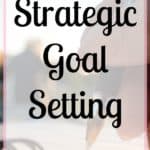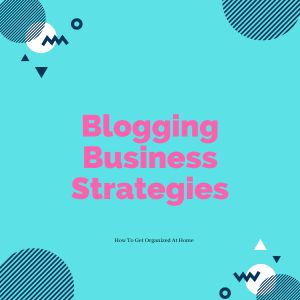How To Save Time As A Full Time Blogger With Strategic Goal Setting
I would like to introduce Eden Fried, she has kindly written this post for us today!
Full-time blogging is sheer and utter chaos. There’s really no other way to say it. It’s hard, it’s time-consuming, and it’s certainly not for the faint of heart.
Full-time bloggers log what feels like countless working hours, and often times it feels like we’re moving at the rate of a sloth [sloths move slowly… like REALLY, really slowly].
That’s why I’ve always been a strong advocate for strategic goal setting for bloggers so that you can SAVE TIME while accomplishing MORE of the important stuff.

Doesn’t that just sound like the absolute dream?
Now some people may wonder if calling goal setting “strategic” is a bit redundant.
When you think about it, isn’t all goal-setting strategic?
Sadly, no, it’s not.
I’ve coached many aspiring bloggers in the past few years, and I’ve found that many bloggers set goals for themselves completely arbitrarily without any regard for their true vision and mission as a blogger.
And, in failing to set strategic goals, they waste a whole lot of time on things that will never help them move their business further in the direction that they hope to head.
It’s sad really.
So that’s what I’m going to address in this post.
Keep reading to learn how to set strategic goals for your blog-business, and how to use those big, lofty goals to plan out your days so that you save time and get more done.
What is strategic goal setting?
A strategic goal is one that aligns perfectly with your ultimate goal.
The act of strategic goal setting enables you to make your vision and mission as a blogger come to life.
Confused? Go with me for a second.
Say you want to be a fitness coach and travel the world hosting major fitness conferences.
A strategic goal for you might be: become a certified instructor of x program by y date.
Strategic goals help you get closer and closer to that big, picture goal you have for yourself.
Now I’m willing to guess that you started your blog for a specific reason.
You obviously have something that you’re incredibly passionate about and want to share with the world.
You have a vision. You have a mission. You want your goal to DO something powerful for you, not only by enabling you to serve others but also by supporting you financially.
In order to make that mission and vision a reality, you need to set strategic goals that will get you closer and closer to that reality.
Everything you do, every goal you set, should lead you one step closer to your big-picture-super-scary-but-incredibly-exciting vision.
Why does strategic goal setting help bloggers save time?
When you set strategic goals for yourself, you allow yourself to focus ONLY on the stuff that actually matters – the stuff that will actually carry you closer to your vision.
And when you’re focusing on those strategic goals, it means you’re NOT focusing on the millions of other seemingly useful but actually distracting tasks that don’t really matter.
For example, if you’re a blogger who wants to make $1,000 per month by the end of the year, you’ll set a goal to create a product to sell in the next 3 months. Instead of focusing on opening yet another social media account, you focus only on developing that product and planning the launch. Why? Because everything else will just detract from your overall productivity, and inevitably will slow down your road to success.
To give you a personal example: I launched a membership site in the beginning of the year and it took me six months to set it up so that it works perfectly well and impresses all my new students. During those six months, I took a break from blogging. I didn’t publish a blog post for 6 whole months! Gasp!
Truth be told, it didn’t match up with my goals at the time and publishing posts would have just been a distraction from my strategic goal at the time. I have zero regrets! And, I’m happy to report that my blog LIVED to tell the tale!
How to set strategic goals for yourself and your blog – step-by-step:
Step one: Identify the destination – where is your blog headed?
The worst thing I ever did as a blogger is launch without asking myself, “Where do I want this to go? Where do I see this in 6 months, 12 months or 5 years from now?”
Now, of course, my blog didn’t combust purely because I didn’t envision the future, but failing to figure out my goals for the future definitely slowed my overall blog growth.
Why?
Because it meant that I spent a butt-load of time working on projects that ultimately led me NOWHERE.
Honestly, if I had done things the “right way”, I probably would be way further along in my business than I am today (not that I’m not doing really well, but just IMAGINE how far I could be from where I am now! Hint: FAR!).
Do yourself a huge favor RIGHT now and answer these questions:
- Where do you see your blog in 6 months from now?
- Where do you see your blog in 12 months from now?
- Where do you see your blog in 5 years from now?
- What role does your blog play in your life 5 years from now?
Remember, you don’t have the destination highlighted and clear in your mind, there’s no way to plan out the road to get there! You’ll end up wasting buckets of time and you’ll find yourself sad, frustrated, among many other unpleasant things.

Step two: Make strides towards that goal by setting smaller SMART goals
Have you ever heard of a SMART goal?
It’s actually an acronym. You may be familiar with this if you’ve ever worked a corporate job.
I’m not a corporate gal, but, hey, I really like this acronym, so let’s go with it.
S – specific
M – measurable
A – actionable
R – realistic
T – timely
S – specific.
Specific means exactly what it sounds like it means. Don’t be vague… be, you guessed it, SPECIFIC. Instead of saying “I want my blog to make money” make sure that you get specific with HOW you want to make that money and HOW MUCH money you want to make and WHEN you want to make that money by.
The good news is that when you set a SMART goal properly, it’s automatically specific, so let’s keep working.
M – measurable.
You need to be able to measure your goal in someway or another in order to stay motivated and track your progress. To make your goal measurable, long how much of something you are striving to reach. For example, maybe you want to earn $10,000 in your first product launch. That’s measurable. Or maybe you want to reduce your churn rate by 50%. Or maybe you want to reduce your customer service complains by 50%. You get the point though.
A – actionable.
What ACTION are you going to take to make your goal? For example, if you want to earn $10,000, HOW are you going to earn that money? Are you going to sell a product? Are you going to sell consulting services? Are you going to rob a bank? Be clear on the ACTION.
R – realistic.
The quickest way to fail a goal is to create one that is completely out of bounds and unreasonable. Say, for example, you have never earned a single dime on your website and you decide, “Hey, this year I’m going to earn ONE BILLION DOLLARS.”
Hmm, come on now. I love your enthusiasm, I truly do, but it’s not realistic.
When bloggers set unrealistic goals, they quickly fall into the deadly trap that I like to call “blogger overwhelm”. And that’s where most blogs go to die.
By ALL MEANS, pick a grand goal. Pick a goal that scares the living daylights out of you. You should be scared by your goal, but it shouldn’t be so unrealistic that even Bill Gates is looking at your goal with his head cocked to the side and eyebrows raised in disapproval.
T – Timely.
You need to set a timeframe for reaching your goal. Any time works – just make sure it’s realistic!
So your homework: go create a SMART goal. Feel free to leave your goal in the comments so we can root you on!
Step three: Write down all the things you feel like you need to do to reach that goal
Congratulations on setting that SMART goal for yourself! Woohoo!
Now comes the really fun stuff – the TO DO list. Of course, it’s not enough to set a goal for yourself, you actually have to put in the work to reach that goal.
Go on and create a list of all the things you feel like you NEED to do.
Step four: Cross off all the things you DON’T actually need to do
Yeah, you read that correctly. Cross of all the things that you don’t actually need to do.
Be honest with yourself, too.
If you set a goal to make $10,000 in the next six months by selling an e-course, you really don’t need to be updating the theme of your website. Sure, you may REALLY want to update your website theme, but does updating your website theme have anything at all to do with selling your e-course? No, not necessarily. Cross it off your list.
Instead, focus on creating the content for your course, growing your email list, developing your launch and sales funnel, and networking with other people who can help you promote your course.
You set a SMART, strategic goal for yourself. NOTHING, and I repeat for the sake of emphasis, NOTHING, matters besides working on the tasks that are going to bring you closer to that goal. Everything else is a waste of your time and a distraction. Strategic goal setting – saves time and helps you do MORE for your business.
Recap
So let’s recap, shall we?
Strategic goal setting helps keep your eyes on the prize and, to that end, your eyes OFF all the things that will distract you from the prize.
When you set strategic goals for yourself, you have more clarity in your business. This clarity will enable you to focus on the important staff and nix all the rest.
A great way to set a strategic goal is to envision where you want to be in a few years, then set a SMART goal in the short-term to help get you closer to that big-grand-goal.
Once you set your SMART goal, create a list of action steps and projects you need to work on that will help you reach that goal – and eliminate EVERYTHING ELSE.
I expect that after you’ve gone through this exercise, you’ll be able to tackle your days with far more energy, drive, and a clear goal-oriented direction. Remember, you CAN beat the odds and make it happen. Just keep putting one virtual foot in front of the other.
I’m rooting for you!
Related article: Blogging for Business: Strategies for Success




